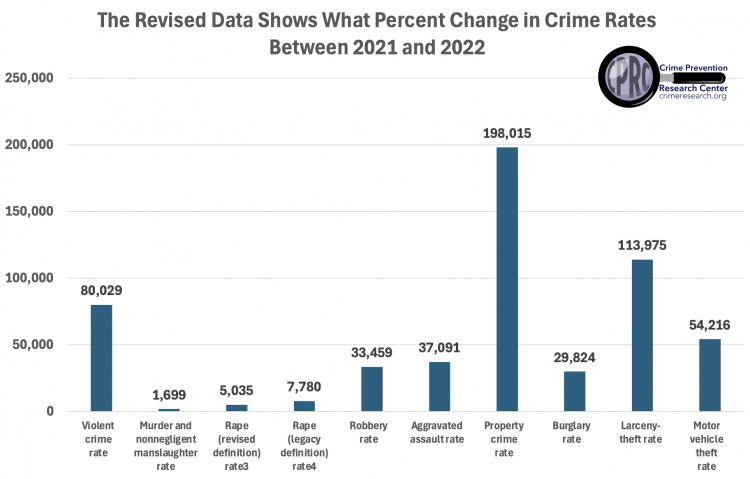
When the FBI first released its 2022 crime data back in September 2023, they proudly reported a 2.1% drop in violent crime. It was a neat, tidy statistic that quickly became a key talking point for the Democratic Party, eager to counter Donald Trump’s claims of soaring crime. But fast forward, and the narrative has quietly changed. The FBI has revised those numbers, and now, instead of a decrease, we see a 4.5% increase in violent crime for 2022. No press release, no headline, just a stealth update—thousands more murders, rapes, robberies, and assaults added to the books without much fanfare.
This revision isn’t just a minor correction; it fundamentally shifts the story the FBI and media were telling us. But if you look at mainstream coverage, like USA Today’s recent headline from late September, you wouldn’t know it: “Violent crime dropped for third straight year in 2023, including murder and rape.” That headline dropped three weeks after the FBI revised their 2022 data. The revised data hasn’t made its way into the narrative—and that seems just fine to the FBI.
Rational Ground by Justin Hart is a reader-supported publication. To receive new posts and support my work, consider becoming a free or paid subscriber.
Take a look at the updated figures:
- 1,699 more murders
- 7,780 more rapes
- 33,459 more robberies
- 37,091 more aggravated assaults

These are not small tweaks—they’re significant. Experts like Carl Moody and Dr. Thomas Marvell have raised concerns about this abrupt adjustment. As Moody pointed out, making such large-scale revisions without providing any explanation erodes trust in the FBI’s data.
The chart above shows how drastically violent crime increased according to the “new” 2022 numbers. Without these revisions, the reported decrease in 2023 would have been less than half—just a 1.6% drop instead of the initially claimed 3.5%. And yet, the media continues to cite the older, incorrect figures, leaving the public none the wiser.
These revisions are a big deal. They don’t just tweak some numbers—they completely change the narrative. And it’s not just the FBI. The Bureau of Labor Statistics recently had to adjust its job creation figures, admitting they overestimated by 818,000 jobs. The FBI’s crime data is similarly impacted by guesswork and estimates—extrapolations from incomplete data reported by local police departments that can end up wildly inaccurate.
What Do These Revised Numbers Mean for Us?
The issue here is that the FBI isn’t always counting actual, reported crimes. Instead, they’re estimating unreported data, adding a hefty dose of guesswork to the mix. These processes have been described as a “black box,” even by other agencies within the Department of Justice. And now, with the revised numbers, the National Crime Victimization Survey (NCVS) tells a vastly different story: while the FBI reports a 3.5% decrease in violent crime for 2023, the NCVS indicates a 4.1% increase. Over Biden’s presidency, the FBI data shows violent crime declining, whereas the NCVS reports a jaw-dropping 55.4% increase since 2020.
These discrepancies are troubling. When one dataset tells us crime is falling, while another shows a surge in violence, it’s clear we’re not getting an accurate picture. The American public deserves transparency, but right now, it’s not happening.
The Erosion of Trust and Transparency
So, why hasn’t the FBI publicly corrected the record? Why the lack of a loud, clear update? This lack of transparency damages credibility—for both the FBI and the media that relies on their data. David Mustard, a crime researcher at the University of Georgia, points out that failing to acknowledge such a major revision raises serious red flags.
At the same time, police forces across the nation are shrinking, with fewer officers and tighter budgets. More crimes are going unreported, which only increases the guesswork going into future “final” crime stats. In many places, unless a crime is actively happening, police might not even respond. Residents are left to go to the police station themselves if they want to file a report. And despite what many might think, a 911 call alone doesn’t get counted by the FBI. They only count crimes when an official report is filed.
The numbers tell a worrying story:
- Only about 45% of violent crimes and 30% of property crimes are brought to law enforcement’s attention, according to the NCVS.
This means the FBI’s numbers represent just a slice of what’s really happening—and that slice is shrinking as more crimes go unreported. Even for categories like murder and auto theft, which are more likely to be reported, the FBI underreported 1,699 murders and 54,216 motor vehicle thefts in 2022, further undermining confidence in their data.
In the end, we need more accountability—from the FBI, the media, and everyone involved in shaping the public narrative. Are crime rates falling, or are they rising? The answer shouldn’t depend on which dataset you look at. Public safety isn’t something that should be subject to stealth edits and estimation errors. Until these discrepancies are fully addressed, it’s hard to trust the story we’re being told about crime in America.
The post FBI’s Stealth Revisions: The 2022 Crime Numbers They Don’t Want You to Notice appeared first on LewRockwell.
[H/T Lew Rockwell]
